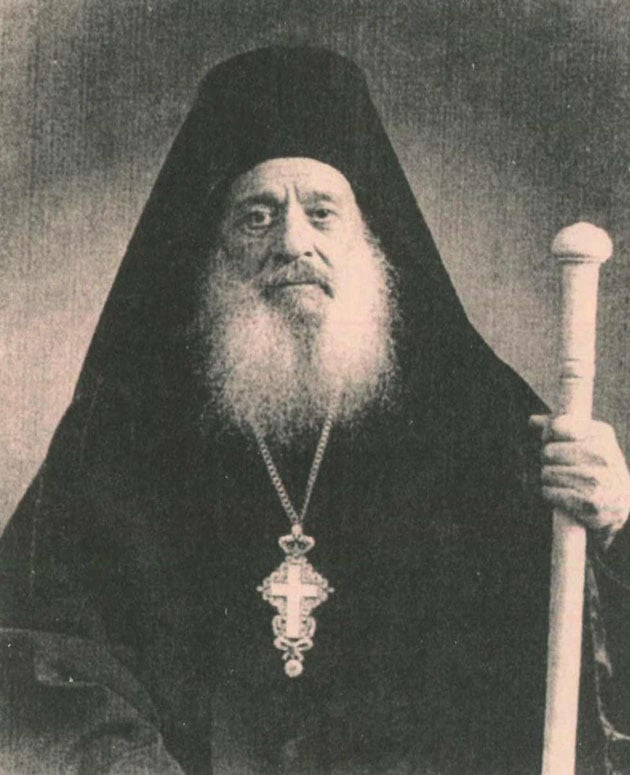Fathers from the Monastery of Saint Paul who have been found worthy to see Our Most Holy Lady here on earth
4 May 2016Your Eminence Ioustinos, Metropolitan of this God-preserved see,
Venerable Fathers, and my beloved children,
I would like to begin by saying that I’m not used to speaking at such gatherings, because my abilities to do so are limited. But, out of obedience and at the invitation of my greatly respected and beloved Chief Shepherd, I’ve summoned the courage to be with you today to say a few words which will, I hope, be constructive.
To be honest, when His Eminence suggested this, I was surprised and tried to back out, justifying my reluctance by saying that there’s no lack of more able speakers and preachers. But with the blessing and good wishes of my venerable Elder and Abbot, Parthenios, I accepted the invitation, which is an honour for someone of my humble station. I found it difficult, however, to find a subject for the talk.
I made the sign of the Cross and knocked at the door of the cell next to mine where an Elder’s been living for more than fifty years. He’s an experienced man, well-practiced in obedience and prayer, so I told him about my dilemma. ‘Should I go and speak? ‘And what should I say?’
With wisdom he answered: ‘Since you’ve got the Elder’s blessing, you should go. And what’s the problem with finding something to say? Talk about the Fathers who’ve lived in our Monastery’. This is why I’ve entitled the talk ‘Fathers from the Monastery of Saint Paul who have been found worthy to see Our Most Holy Lady here on earth’. These were men whom we had the blessing to know.
So, armed with the blessing of His Eminence and of the holy Fathers, I’ve come here today to be with you.

First let me tell you about the holy Elder, Papa-Andreas, who arrived in the Monastery in August, 1934, became a monk, then a priest-monk and, in 1960, Abbot. His term as Abbot was divided into two periods: from 5/4/1960 to 6/10/1962; and from 3/6/1969 to 21/10/1974.
When he resigned in 1974, he went to the Monastery’s dependency of Monoxylitis, which is also on the Holy Mountain, where he lived in prayer and contemplation.
While he was there, one day there was a terrible storm, with a very choppy sea. When the storm passed, Papa-Andreas set off to go down to the sea near the Dependency to see what was going on, collect some of the wood that a storm usually brought to land and find out if perhaps there was somebody there in need of help. Between the dependency and the sea there’s a small stream, with a large rock next to it. On his return, what should the Elder see sitting on the rock but a woman dressed in black.
He immediately thought she must be in need of help so he rushed to her aid. As he approached, he saw that the woman was holding three books in her hands. He was astonished and dumbfounded and asked her in his distinctive accent- he was from Kefallonia: ‘What do you want here, madam? Do you need any help?’ And the woman, who appeared to be a nun, replied: ‘No, I’m the Lady of this place’.
‘And what are those books you’re holding, madam?’, he asked. She answered: ‘One is where I write the names of those who come to the Holy Mountain; the second is where I write the names of those who leave the Holy Mountain; the third is where I write the names of those who stay and end their lives on the Holy Mountain, and that’s the book of life’.
Papa-Andreas then went up to the Dependency, without the slightest disturbing thought. At the hour of Vespers, he went into the chapel and read the service. After that he read Compline, and, as he was reading the Salutations in front of the icon of Our Lady, his mind suddenly cleared and he thought: ‘What was that woman doing on the Holy Mountain? Was she a temptation or Our Lady?’.
At that moment the lamp in front of the icon began to swing and he felt a heavenly joy and spiritual exaltation.
He immediately ran to the spot where he’d seen the vision and, on the way, he thought that it must be because of his sins that he hadn’t recognized Our Lady. He looked carefully all around, but didn’t see anything. But the place did exude a heavenly fragrance.
After this, the wise and practical Elder called on his spiritual guide, the late Papa-Dionysios Mikrayiannitis, and asked if what he had seen was a divine vision or a demonic act. His spiritual guide assured him it was Our Lady and he accepted that.
They kept this a secret and it wasn’t until the Elder fell asleep in the Lord that his spiritual guide revealed what had happened to those present at his funeral. Because of his veneration of Our Lady, the Elder was counted worthy to depart this life on the day of the Reception of the Lord (February 2) 1987, which is the feast-day of our Monastery.
May we all have his blessing.
(Speech given at an Assembly of Young People of the HolyMetropolis of Nea Krini and Kalamaria, during Great Lent, 2016).






